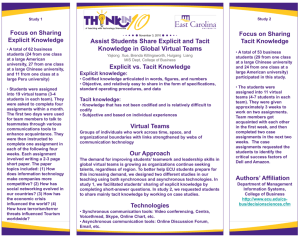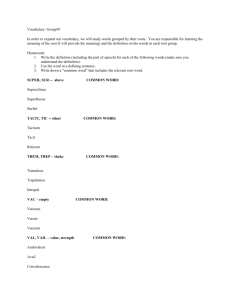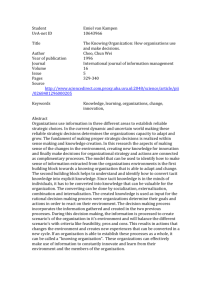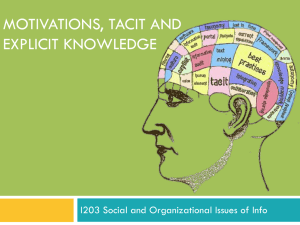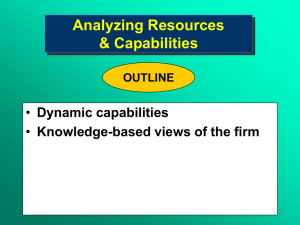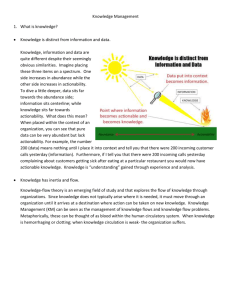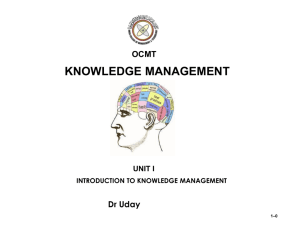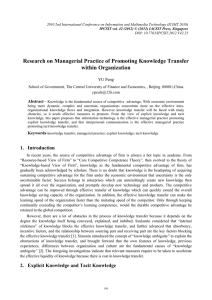Overview of Knowledge Management in Organizations
advertisement
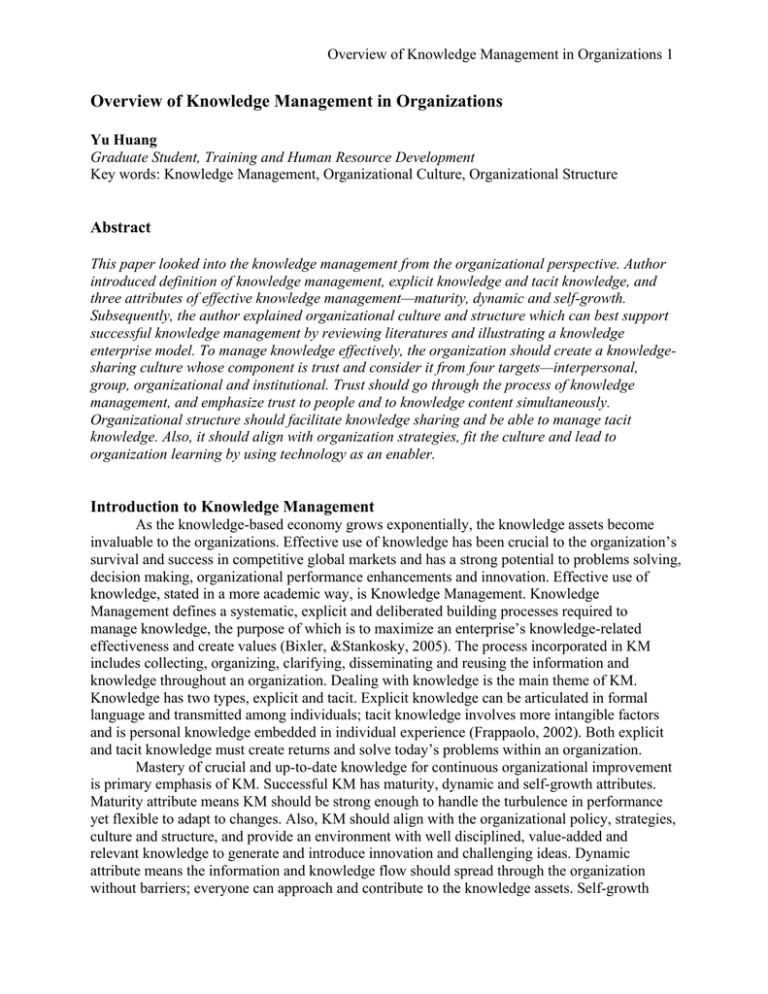
Overview of Knowledge Management in Organizations 1 Overview of Knowledge Management in Organizations Yu Huang Graduate Student, Training and Human Resource Development Key words: Knowledge Management, Organizational Culture, Organizational Structure Abstract This paper looked into the knowledge management from the organizational perspective. Author introduced definition of knowledge management, explicit knowledge and tacit knowledge, and three attributes of effective knowledge management—maturity, dynamic and self-growth. Subsequently, the author explained organizational culture and structure which can best support successful knowledge management by reviewing literatures and illustrating a knowledge enterprise model. To manage knowledge effectively, the organization should create a knowledgesharing culture whose component is trust and consider it from four targets—interpersonal, group, organizational and institutional. Trust should go through the process of knowledge management, and emphasize trust to people and to knowledge content simultaneously. Organizational structure should facilitate knowledge sharing and be able to manage tacit knowledge. Also, it should align with organization strategies, fit the culture and lead to organization learning by using technology as an enabler. Introduction to Knowledge Management As the knowledge-based economy grows exponentially, the knowledge assets become invaluable to the organizations. Effective use of knowledge has been crucial to the organization’s survival and success in competitive global markets and has a strong potential to problems solving, decision making, organizational performance enhancements and innovation. Effective use of knowledge, stated in a more academic way, is Knowledge Management. Knowledge Management defines a systematic, explicit and deliberated building processes required to manage knowledge, the purpose of which is to maximize an enterprise’s knowledge-related effectiveness and create values (Bixler, &Stankosky, 2005). The process incorporated in KM includes collecting, organizing, clarifying, disseminating and reusing the information and knowledge throughout an organization. Dealing with knowledge is the main theme of KM. Knowledge has two types, explicit and tacit. Explicit knowledge can be articulated in formal language and transmitted among individuals; tacit knowledge involves more intangible factors and is personal knowledge embedded in individual experience (Frappaolo, 2002). Both explicit and tacit knowledge must create returns and solve today’s problems within an organization. Mastery of crucial and up-to-date knowledge for continuous organizational improvement is primary emphasis of KM. Successful KM has maturity, dynamic and self-growth attributes. Maturity attribute means KM should be strong enough to handle the turbulence in performance yet flexible to adapt to changes. Also, KM should align with the organizational policy, strategies, culture and structure, and provide an environment with well disciplined, value-added and relevant knowledge to generate and introduce innovation and challenging ideas. Dynamic attribute means the information and knowledge flow should spread through the organization without barriers; everyone can approach and contribute to the knowledge assets. Self-growth Overview of Knowledge Management in Organizations 2 attribute means, on one hand, KM should sense potentially valuable knowledge, capturing and storing it to increase organizational knowledge assets, and on the other hand it should create new knowledge based on what an organization already has had. KM can profit organizations, for instance, leveraging the intellectual capital, utilizing knowledge assets, sustaining cutting-edge performance. Such as GE, Microsoft and Intel, their net worth incensement which can be attributed to KM up to 82%, 97% and 85% respectively (Frappaolo, 2002). In organizational perspective, creating culture and structure that can foster KM are the key points. Knowledge Management and Organizational Culture Organizational culture is a big factor impacting success of KM. KM should be supported in a knowledge-sharing culture, and trust is its most important component (Ford, 2001, & Figallo, 2002).Dianne Ford (2001) summarized trust into interpersonal, group, organizational and institutional targets (Figure 1). Interpersonal trust Group trust (Rousseau, et al., 1998) Organizational trust Institutional trust The “willingness of one person to increase his/her vulnerability to the actions of another person [e.g., Zand 1972]” (Aulakh, Kotabe & Sahay, 1996, p. 1007). Also defined as “generalized expectancy that the verbal statements of others can be relied upon” (Rotter, 1967, p. 651). The willingness of one person to increase his/her vulnerability to the actions of a group of people. “Organizational trust is a feeling of confidence and support in an employer… organizational trust refers to employee faith in corporate goal attainment and organizational leaders, and to the belief that ultimately, organizational action will prove beneficial for employees” (Gilbert & Li-Ping Tang, 1998, p. 322). Institutional trust is a feeling of confidence and security in institutions (e.g., the law, organizations), that the laws, policies, regulations, etc. are to protect the individual’s rights, and will not harm her/him. Figure 1. Trust Targets (Ford, 2001, p. 31) Overview of Knowledge Management in Organizations 3 Trust is the channel through which the knowledge can be exchanged smoothly .High level of trust in organizational culture can facilitate knowledge sharing, particularly tacit knowledge. Because sharing knowledge is a risky action, people are more inclined to conceal what they have known if they are uncertain with outcome of sharing. So building trust is the first step to effective KM. In KM, trust entails trust to people and trust to the knowledge content itself. Trust to people is a key element promoting collaborative and participative culture in the organization, which can break down the barriers to the knowledge sharing. Trust to knowledge content will increase the credibility of knowledge, which can make people use knowledge without concerns and improve the trust to other people immediately. Researchers also pointed other components of knowledge-sharing culture, like ownership of knowledge and liability (Frappaolo, 2002) Ownership of knowledge can be categorized into organizational trust. As defined in Table 1, it more stresses what the organization can do for the employees. The organization should support the employees’ work, provide necessary knowledge required to accomplish the task, be receptive to criticism, and encourage truth. The knowledge assets do not only belong to the leaders. It should be shared with everyone in the organization. All the members have the right to own and retrieve the knowledge assets. Furthermore, the organization should created an atmosphere which make employees feel the equal access to knowledge assets and responsible for making contribution. Participative leadership, open communication and knowledge reward can be the means to increase the organization trust. As far as liability, it can be categorized into institutional trust. Liability plays an important role in knowledge security, especially in inter-organizational setting where scope of knowledge exchange often reaches to a large market (Ford, 2001, &Frappaolo, 2002). The knowledge sharing between organizations needs more trust to drive the knowledge exchange and also more protection on security. Trustable laws, policies and regulations are powerful tools to protect people’s right and to ensure no harmful impact of knowledge sharing action. And most of time, shared knowledge is not present in a neat and official format, so under control of laws and policies will make it more convincible and avoid problems (Figallo, 2002). Interpersonal trust, group trust, organizational trust and institutional trust are interdependent throughout the KM process and do not necessarily begin with interpersonal trust (Ford, 2001). Trust is essential to the organizational culture, not only in KM, but in all managerial function leading to organization’s success. Organizations should reward knowledge contribution and encourage learning. As the key component of knowledge sharing culture, trust is the ground of knowledge-related action in an organization. Knowledge Management and Organizational Structure Another issue regarding effective KM is organizational structure. To better implement KM, some organizations place the positions entitled with, for instance, chief knowledge officer (CKO), knowledge engineer, knowledge analyst, knowledge manager, knowledge steward to administrate knowledge management (KM). And along with the development of information technology (IT), Knowledge Management System (KMS) has been integrated in organizational structure to assist in managing knowledge through intranet or internet. Figure 2 shows organization structure which can support KM. Overview of Knowledge Management in Organizations 4 Figure 2. Knowledge enterprise mode (Anantatmula, &Stankoshy, 2005, p.174) From Figure 2: 1. Major issues in organizational structure are interaction and strength on tacit knowledge. The organization structure should be networked to provide opportunities for employees to interact and communicate with others, and support knowledge- related actions. Because it is intangible and more relevant to personal feelings, managing tacit knowledge is more difficult than explicit knowledge. Organization structure should be able to handle tacit knowledge, and change it into explicit knowledge if necessary. 2. Technology is only an enabler. Because of advanced information technology, knowledge management systems, expert systems, knowledge base systems and other high-tech products are available for organizations to manage knowledge. Technology is merely a tool. Human factor is the key to effective and efficient KM. 3. Organizational structure should align with the strategies and fit in a trust and open culture environment. Organizational structure should be in line with the organization strategies, goals, mission and vision, and encourage employee to learn. In the organizational structure, there should be a connection between individual improvement and organization improvement. System thinking approaches should be integrated into the structure. Overview of Knowledge Management in Organizations 5 4. Organizational structure should result in organization learning. Organization learning is a broad topic. Here just list some suggestions that may help in organization learning: • Provide continuous learning opportunities. • Use learning to reach their goals. • Link individual performance with organizational performance. • Foster inquiry and dialogue, making it safe for people to share openly and take risks. • Embrace creative tension as a source of energy and renewal. • Are continuously aware of and interact with their environment. (Kerka,1995) Conclusion Knowledge Management is a systematical process which includes collecting, organizing, clarifying, disseminating and reusing the information and knowledge throughout an organization. KM deals with explicit knowledge and tacit knowledge and should possess maturity attribute, dynamic attribute and self-growth attribute. Successful KM needs a trust-based organizational culture to facilitate knowledge sharing and should be supported by an organization structure which can result in organization learning and fits in the trust and open cultural environment. References Anantatmula, V.S. (2005). Knowledge Management Criteria. In M. Stankoshy. (Ed.).Creating the Discipline of Knowledge Management: The Latest in University Reserch (pp.171188).Amsterdam, Boston: Elsevier Butterworth-Heinemann. Bixler, C.H. (2005). Developing a Foundation for a successful Knowledge Management System. In M. Stankoshy. (Ed.).Creating the Discipline of Knowledge Management: The Latest in University Reserch (pp.51-65).Amsterdam, Boston: Elsevier Butterworth-Heinemann. Figallo,C. (2002). Building the Knowledge Management Network—best Practices: Tools and Techniques for Putting Conversation to Work. New York: John Wiley& Sons, Inc. Ford, D (2001). Trust and Knowledge Management: The seeds of Success. Retrieved May 4th , 2007, From http://business.queensu.ca/centres/monieson/docs/working/working_01-08.pdf Frappaolo, C. (2002). Knowledge Management. Oxford: Capstone Publishing Ltd. Kerka, S. (1995). The learning organization: myths and realities. Retrieved May 4th ,2007, Form http://www.cete.org/acve/docgen.asp?tbl=archive&ID=A028.

